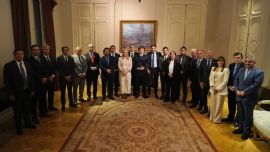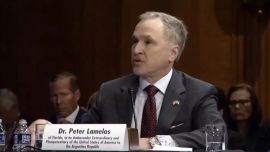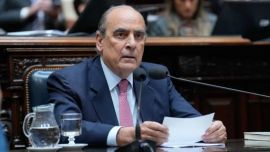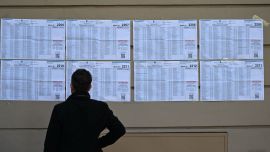In the run-up to what looks like will be a shoo-in victory this weekend, presidential candidate Alberto Fernández has been trying to calm down panicked bond investors. Sort of. He isn’t really saying he won’t seek debt relief. He’s just saying it won’t be that painful.
To make the point, Fernández has repeatedly referred to the default – or the reprofiling, as he likes to call it – in neighbouring Uruguay in 2003 as a model for what he’d like to do to make Argentina’s US$100-billion debt load more manageable. Back then, Uruguayan officials left the principal on about US$5.3 billion of foreign-currency bonds untouched and just pushed out maturities an average of five years, saddling creditors with losses of about 20 percent.
Argentine bondholders, though, don’t appear to be swayed by his pitch in the slightest. Having driven the price on sovereign notes down to a mere 40 cents on the dollar, they continue to brace for losses that are much greater than those imposed by Uruguay.
That gap in expectations – equal to roughly 40 percentage points – also effectively marks the credibility gap that Fernández will confront when he takes office in December and ushers in the return of the populist Peronist party that antagonised investors at almost every turn during their recent 12-year rule.
“The market is expecting a much more pessimistic solution,” said Sebastian Cisa, the head of operations at the Buenos Aires-based brokerage SBS Trading. “The Uruguayan solution is not feasible.”
If only it were. The deal, supported by the International Monetary Fund, mostly worked well for everyone. Investors took the initial hit in net present value by accepting longer maturities, but the bonds eventually outperformed peers. Uruguay got the debt relief it needed, paving the way for fast economic growth thanks to a boom in prices for commodities.
One of the bonds handed to investors in the restructuring, a dollar-denominated note due in 2033, has returned about 550 percent since the exchange, more than double the average for hard-currency emerging-market debt during that span.
But the situation Argentina finds itself in is much different than Uruguay faced in 2003. For one, there’s the contrast in scale – Argentina has a little over US$30 billion of foreign-currency bonds it wants to renegotiate, about six times as much as Uruguay. In addition, while Uruguay had primary budget surpluses at the time, Argentina is running a deficit and Fernández has pledged to boost social spending.
Economically viable
Given that backdrop, debt relief that just extends maturities instead of cutting into the principal “would require too much of a fiscal adjustment to be politically or economically viable,” Fitch Ratings said in a statement October 24. “It would weigh further on an economy entering its third year of recession, and political appetite for fiscal adjustment appears weak.”
TPCG Valores, a brokerage in Buenos Aires, found most traders think similarly. It surveyed investors in London and New York earlier this month and found that three out of four would be willing to take up to a 25 percent cut to face value.
To be clear, Fernández has never put a number on the losses he’s seeking to impose on creditors, and his press office declined to comment for this article. But in mentioning the Uruguay case repeatedly – he’s brought it up at least half-a-dozen times in recent campaign appearances – he’s indicating it will be nothing like the crippling default that Argentina carried out in 2001. What’s more, he suggests that as long as there’s no cut to the face value of the debt, the restructuring wouldn’t even qualify as a default, an opinion that ratings companies don’t share.
“I’ve already lived through a default and it’s very hurtful for society,” he said. “No one could want a default as a solution.”
Ray Zucaro, the chief investment officer at RVX Asset Management, doubts that Argentina will be able to restructure without reducing the amount it owes, but he thinks investors are overly pessimistic about what awaits them.
“They’re going to need a reprofiling, whether it’s hard or soft,” he said in an interview from Buenos Aires. “But I think Argentina is going to get through it.”
Decades of defaults
Argentina has stumbled from one solvency crisis to another in the last 70 years as governments over-borrowed to finance spending on entitlement programmes and political patronage.
President Mauricio Macri, who took office in December 2015, tried to avoid spending cuts with a plan to load up on debt until foreign direct investment boosted growth and tax revenue. Instead, the economy languished and he had to seek a record US$56-billion IMF credit line last year. Gross domestic product is forecast to shrink a third straight year in 2020.
Amid a sharp drop in the peso’s value, Macri suffered a stunningly poor showing in August’s primaries, signalling Fernández would likely be the next president, and the one to deal with the task of restructuring US$101 billion of debt, including local notes, foreign bonds and the IMF credit line.
Fernández soon latched on to the comparison with Uruguay.
The nation of 3.5 million people, situated between Argentina and Brazil, has an economy less than one-10th the size of Argentina’s. But the countries were so intertwined at the turn of the century that Argentina’s US$95-billion default in 2001 essentially caused a banking crisis that led to one of Uruguay’s worst recessions in modern times and compelled the smaller country to restructure its debt shortly thereafter.
Uphill battle
President Jorge Batlle’s government slashed spending and raised taxes to restore faith in public finances, while winning about US$3.8 billion in support from the IMF and other multilateral lenders between March 2002 and the end of 2004. That created a favourable backdrop for seeking the debt relief.
Isaac Alfie, the Finance Ministry’s chief economist at the time, recalls it was an uphill battle to convince a sceptical IMF that Uruguay was suffering a temporary liquidity crunch and not a solvency crisis. The Uruguay government’s economic plan, which included growth-friendly measures, also played a role in getting the IMF on board and placating bondholders, he said.
The IMF has said it’s waiting to hear Argentina’s economic plan before engaging in any talks. Even before Fernandez’s surprise sweep of the August primaries, emerging market funds from the likes of JPMorgan, Goldman Sachs and DoubleLine had trimmed their Argentine exposure, according to data compiled by Bloomberg.
Ezequiel Zambaglione, the head of strategy at Balanz Capital Valores, is among the pessimists. He says that investors want a plan that’s sustainable over the long term, to avoid everyone being back in the same situation a few years from now.
“Investors now need to see delivery. They need to see these guys reaching a friendly restructuring process,” Zambaglione said in an interview. In the absence of anything concrete, “that’s why a good chunk of investors have said right now they are pricing in a large haircut.”
by Scott Squires & Ken Parks, Bloomberg

























Comments